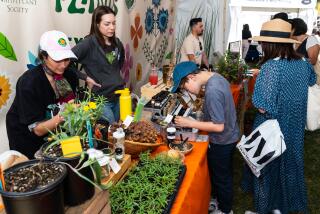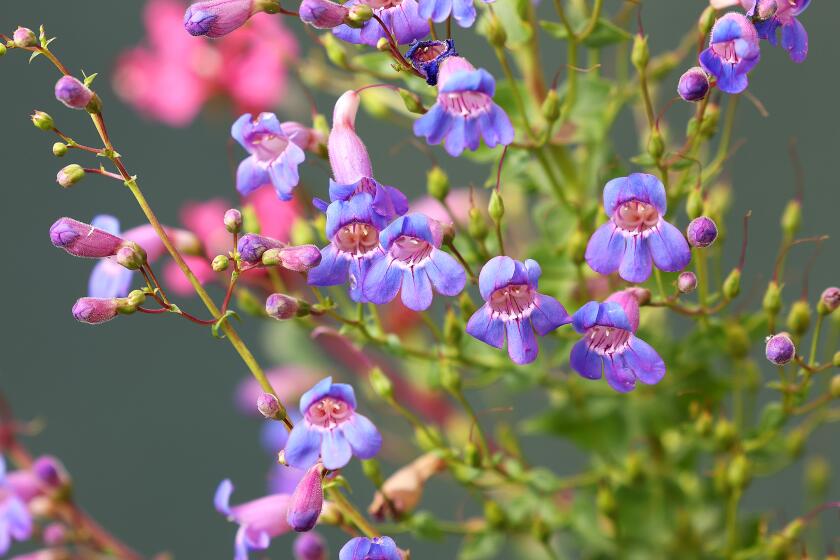Strawberry Fields Endeavor : UC Pomologist Gambles in Trying to Create the Perfect Product for Growers--but if His Labors Bear Fruit, He May Be Without a Job
- Share via
IRVINE — Fruit scientist extraordinaire Kirk D. Larson, Ph.D, perched himself atop a wooden stool in a furrowed field of stubby, green plants.
Then he lifted up a plump, red fruit, studied it keenly, and offered some wisdom about his quest to create the “super strawberry.”
For Larson, 40, it is the ultimate challenge.
“Breeding strawberries is like breeding Thoroughbred racehorses,” Larson said. “It’s all in the bloodlines. You try to mate high-quality, high-performance plants with each other. You wouldn’t pick a beat-up, old horse that’s never won a race to breed with a promising mare, would you?”
Larson should know.
The pomologist, or fruit scientist, has created more than 12,000 strains of strawberries since coming to the University of California South Coast Field Station two years ago. The station is a 200-acre research center in east Irvine.
In his search for edible perfection, Larson picks two strong, productive “parents” and then “acting like a bee,” he transfers the pollen from selected plants, hoping that it eventually produces firm, tasty offspring.
Ideally, the super strawberry plant would yield a large number of firm, sweet, big and disease-resistant fruits from January to June.
Larson’s work is especially vital for Orange County’s strawberry industry, which in 1992 harvested 50,000 tons and earned more than $40 million at market.
Orange County produces 15% of the state’s strawberries, according to the California Strawberry Commission, and the state produces 85% of the strawberries consumed in the United States.
These days, county growers are working feverishly to harvest ripe fruit. The strawberry season in Orange County runs from January to June, but peaks in April when the longer, warmer days increase the plants’ production of fruit.
So far, this year’s harvest is a complete turnaround from a year ago, when heavy rains drowned the sensitive crop. Although last year’s figures are not available, 1993 may have been the worst year in the county’s strawberry industry.
With Larson’s research, which also includes studies on how strawberry plants react to certain pesticides, growers hope to learn how to increase their production, ensure plant health and, of course, achieve the elusive super strawberry.
“As growers, we are always looking for a strawberry with good taste and (one that) ships well,” said A.G. Kawamura, who runs the family-owned business, Western Marketing Co., of Fullerton.
“Firmness, size and sweetness are key characteristics we look for,” said Kawamura, who sends his strawberries to Philadelphia, London and Singapore.
Much of Larson’s effort is aimed at making Orange County growers more competitive within the state. Although strawberry growers harvest crops from San Diego to Watsonville, subtle temperature and other environmental differences alter the quality and nature of the fruit.
Although Larson has bred thousands of different strawberry plants and some have been planted by local growers, he said few, perhaps a dozen or so, have the right stuff to challenge the industry’s longstanding favorite: the Chandler strawberry.
Introduced nearly a decade ago and patented by UC, the Chandler is grown and sold worldwide, and has long been revered by growers for its firmness, consistency and size, although some experts say it could be sweeter.
“It takes five to eight years of research and testing before you can introduce a new variety to growers,” Larson said.
Even if the parent plants have good qualities, each plant has eight chromosomes and creating the perfect fruit is like “rolling 30 dice and trying to get snake eyes,” Larson said.
Before Larson came to the 35-year-old South Coast Field Station, legendary pomologist Victor Voth ran the strawberry program, developing several varieties now being used in Orange County fields.
Larson’s project, funded by UC and the California Strawberry Commission, is one of nearly 50 ongoing fruit and plant studies at the field station.
Over the years, the field station developed several hybrids, including the Gwen and Wetshel avocados and the Toro Turf used on golf courses.
Working closely with growers, the strawberry project has traditionally attempted to create fruit that is not only firm, shapely and tasty, but also bug- and disease-resistant, Larson said.
They have also tried to find a strain of strawberry that will produce a lot of fruit during the typically slow months of January and February.
As his research continues, Larson is both hopeful and fearful of what he may discover.
“I want to create the perfect strawberry,” Larson said, “but if I do, I’ll be out of a job.”






